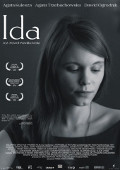
Directed by
Pawel Pawlikowski
80 minutes
Rated M
Reviewed by
Bernard Hemingway

Ida
Synopsis: Anna (Agata Trzebuchowska), a young novitiate nun in early 1960s Poland is on the verge of taking her vows when she discovers a dark family secret dating back to the years of the Nazi occupation.
Polish-born director Pawel Pawlikowski’s previous film, 2011’s The Woman in the Fifth, was a typically stylish but dispassionate art-house thriller so it is something of a surprise that his latest film is both a meticulous homage to New Wave Polish film-making of the 1950s and '60s and a rigorously spare study of religious faith, one which recalls the masterly works of Carl Dreyer.
First time screen actress Agata Trzebuchowska is a true Dreyer heroine as Anna, a quietly unworldly novitiate nun who has lived her entire life in the convent where she was left as a baby during WWII. The Mother Superior decides that before committing herself to the Lord, Anna must visit her only surviving relative, her aunt (Agata Kulesza). The aunt is a hard and cynical woman who initially rejects Anna but moved by the latter's humility and unworldliness, she relents. Not a little affected by drink the aunt first tells Anna that her real name is not Anna but Ida and that she is Jewish. She then takes her on a road trip to discover what happened to Ida's parents during the war.
One would at times be hard-pressed to distinguish this film from actual instances of 1950s Polish film such as Andrzej Wajda’s WWII trilogy, A Generation, Kanal, and Ashes and Diamonds – the bleak wintery landscape, the dilapidated buildings, the poverty and drabness of Communist-era Poland are flawlessly captured by the grainy black and white photography whilst the use of a square image ratio effectively conjures up the low-fi resources of the time. A sub-plot involving a sax-playing hitch-hiker allows intimations of the first stirrings of 1960s Polish youth culture and, for Anna, a taste of the temptations of the material world.
These things are matters of content but Pawlikowski also makes marvellous use of the form of his imagery, particularly the possibilities of illumination and composition, to speak to us. Ida is a film in which the image serves not simply as a vehicle for the narrative but is meaningful in itself. It is in this respect that one recalls the films of Dreyer such as The Passion of Joan of Arc and Gertrud with their focus on intense and, specifically female, mystic awareness.
Although no doubt Ida will resonate most strongly with those familiar with Polish history, the issue of Christian anti-Semitism and role of the Catholic Church in endorsing Nazi ideology is readily apparent. Such things are vital to the film’s intent but Pawlikowski, who co-wrote the film with Rebecca Lenkiewicz, has managed to embody them in an economical but powerful way through the simple and immediate story of two very different women, superbly brought to the screen by Trzebuchowska and Kulesza. A mere 80 minutes long, Ida is a film that rewards on many levels.

Want more about this film?


Want something different?




